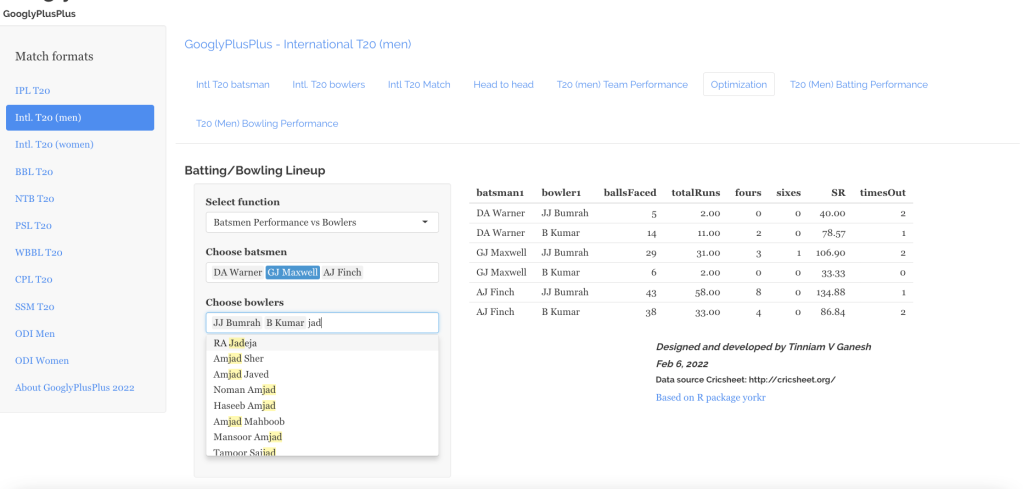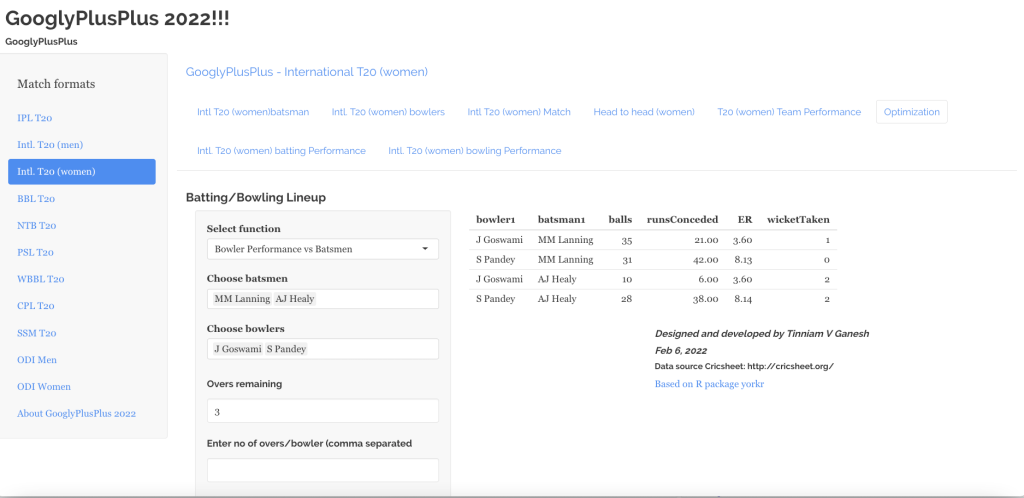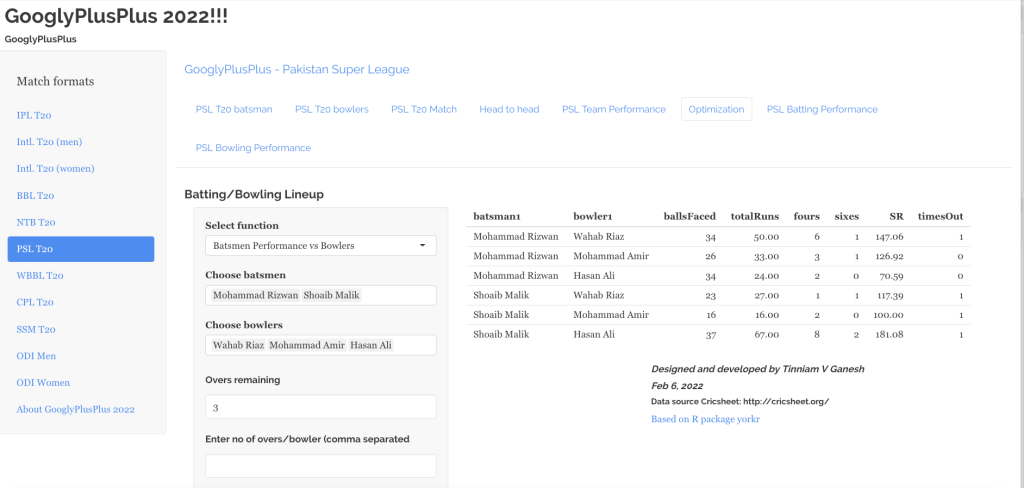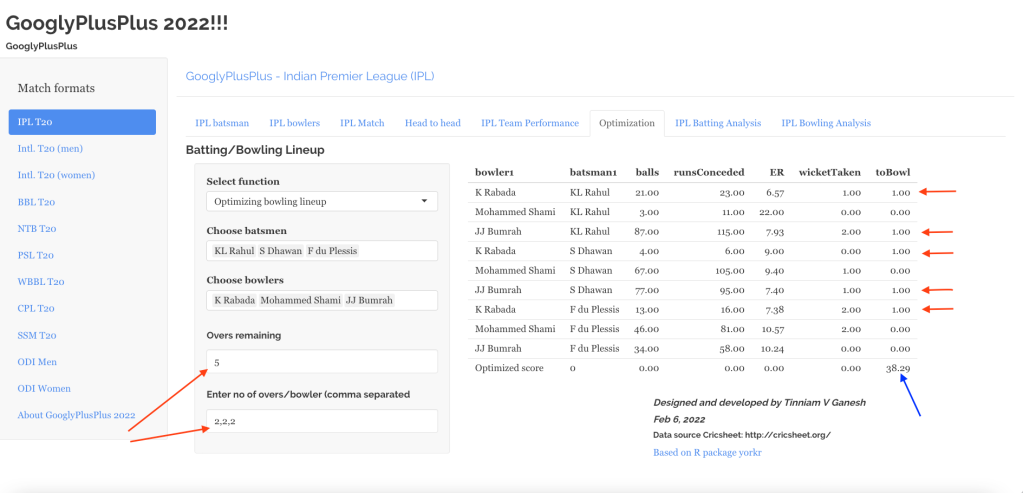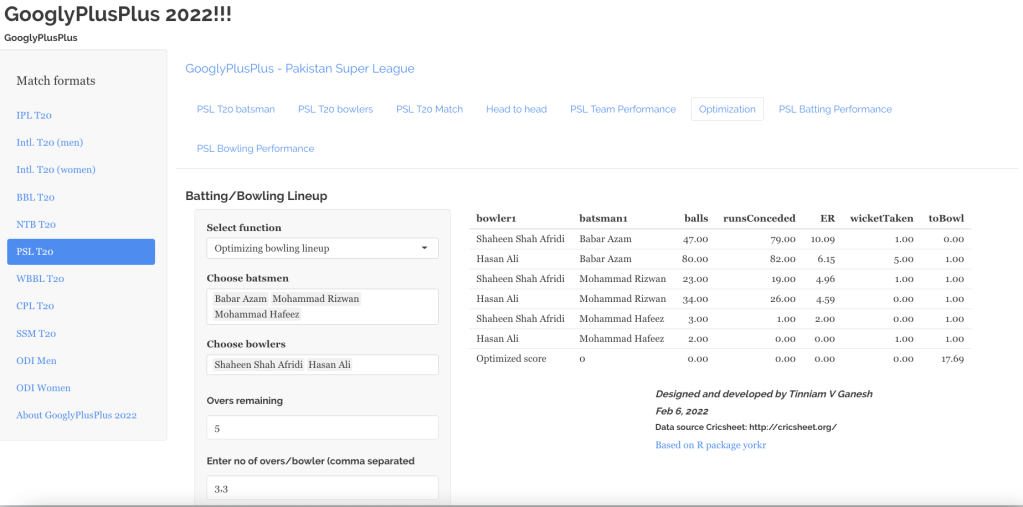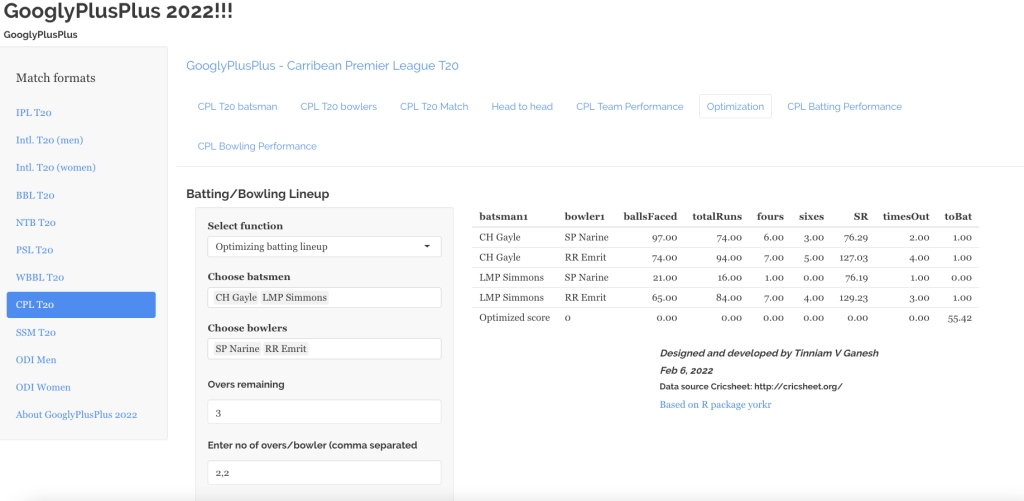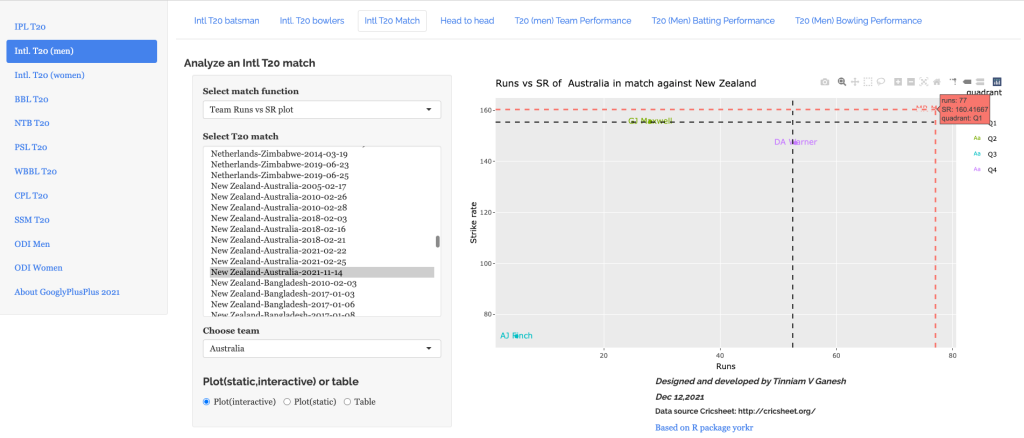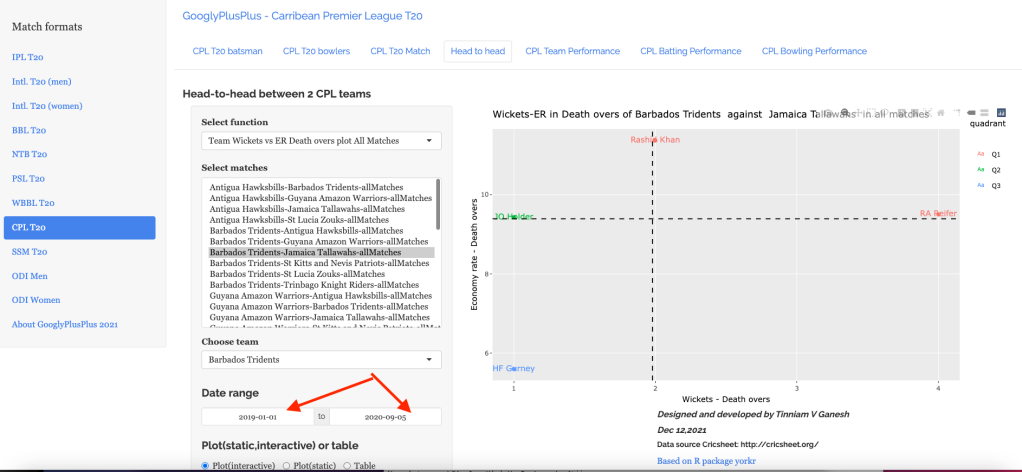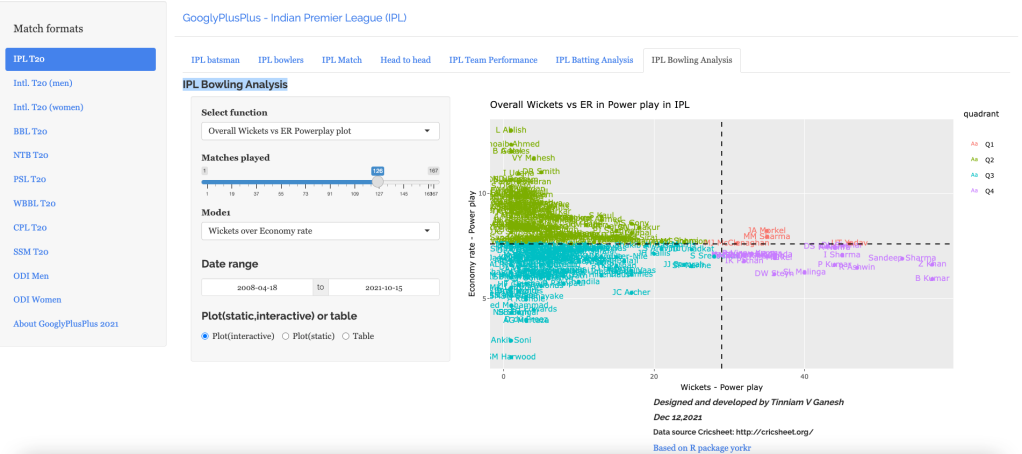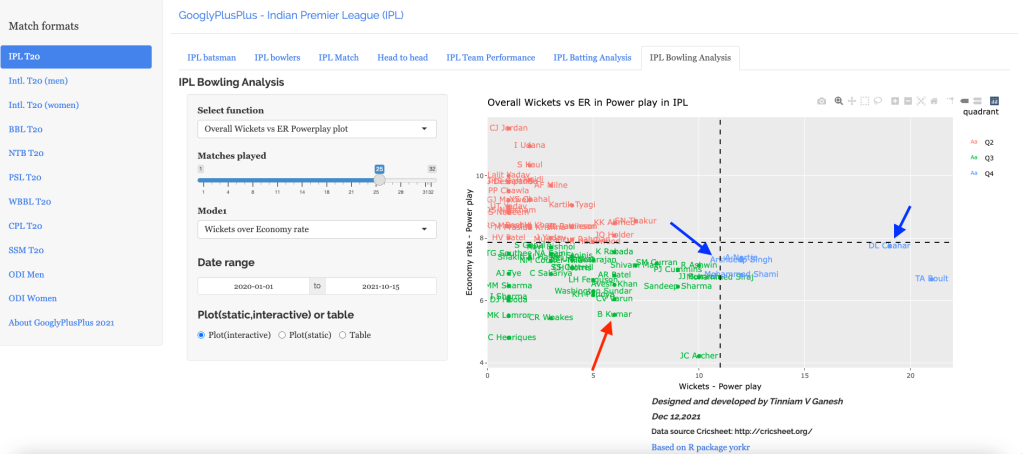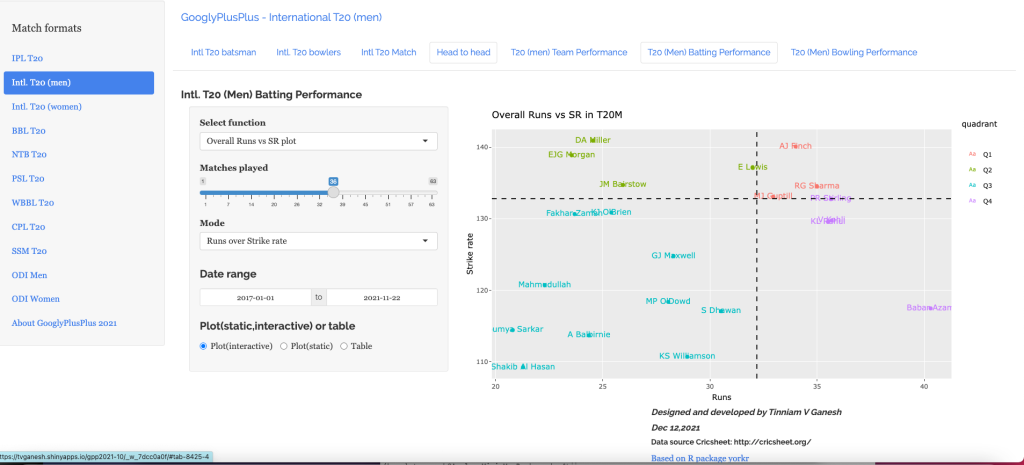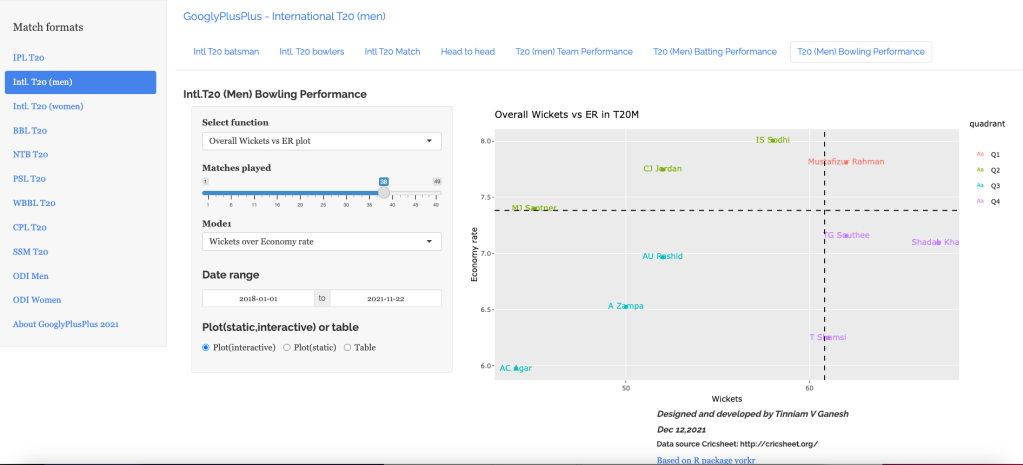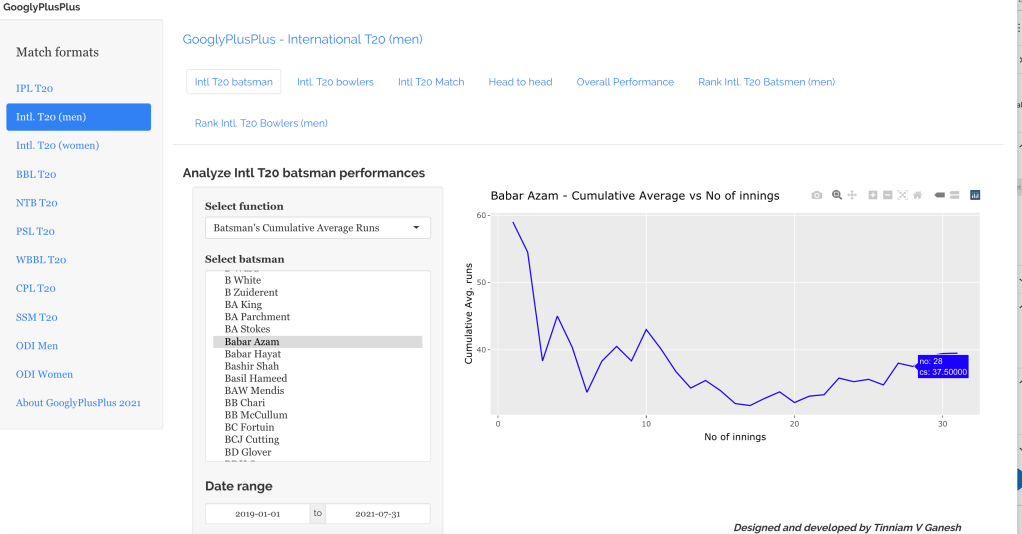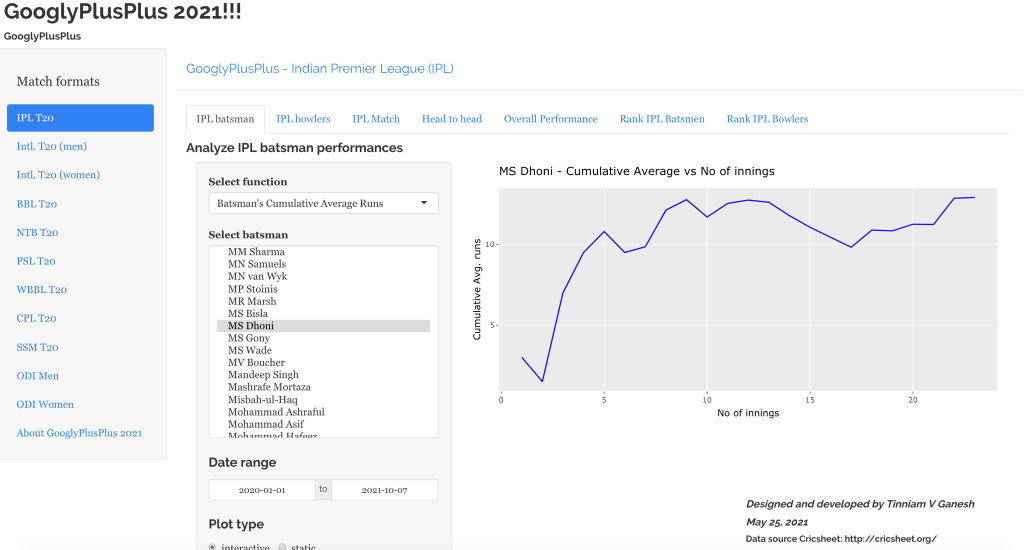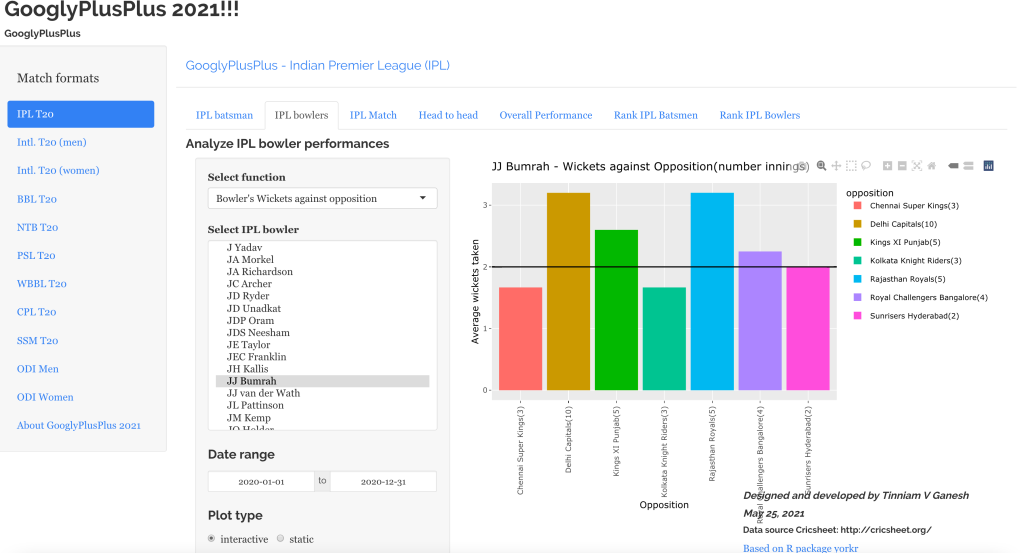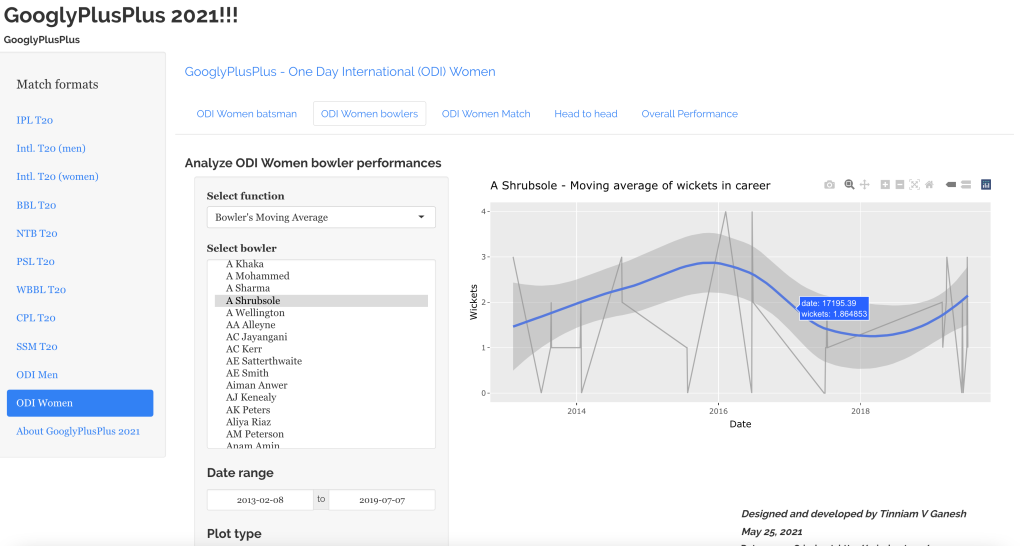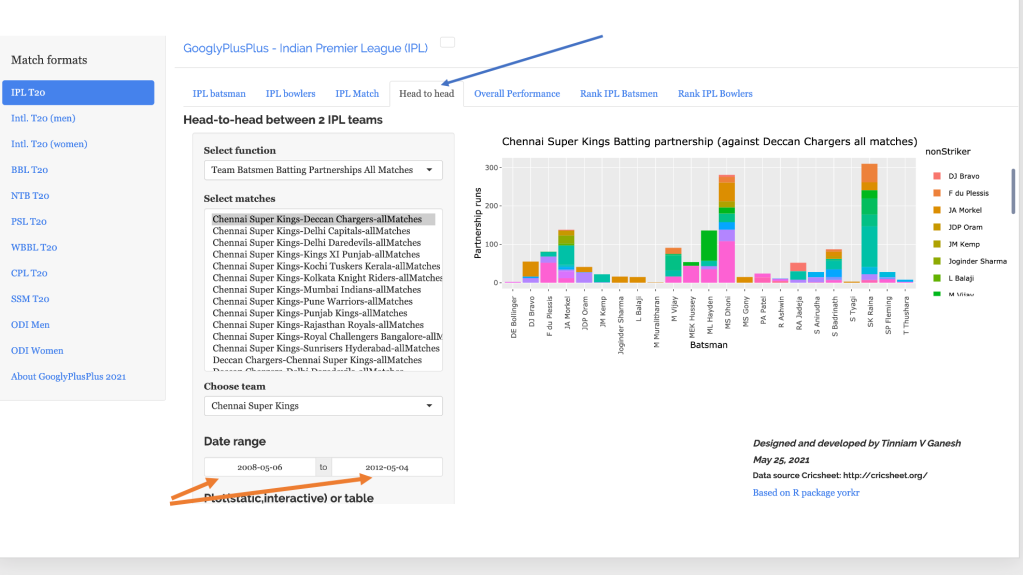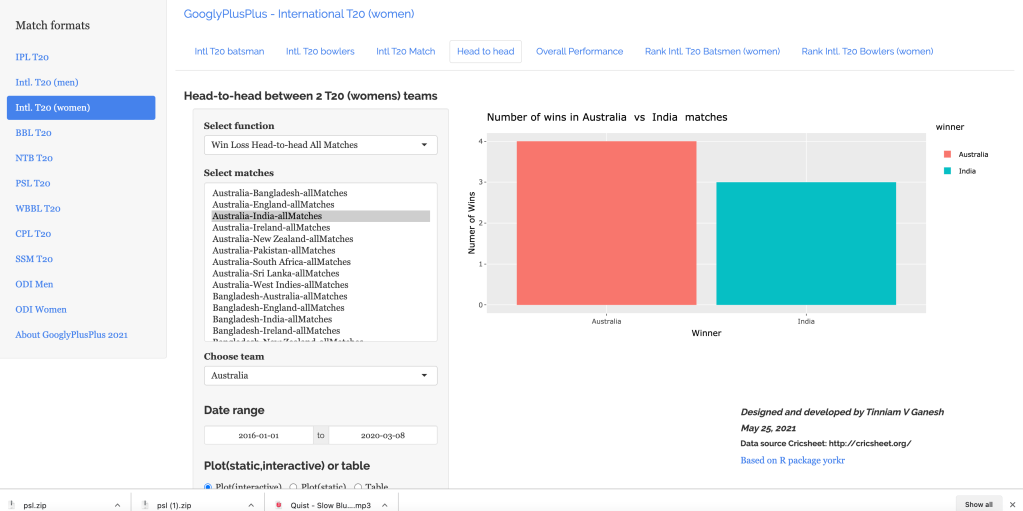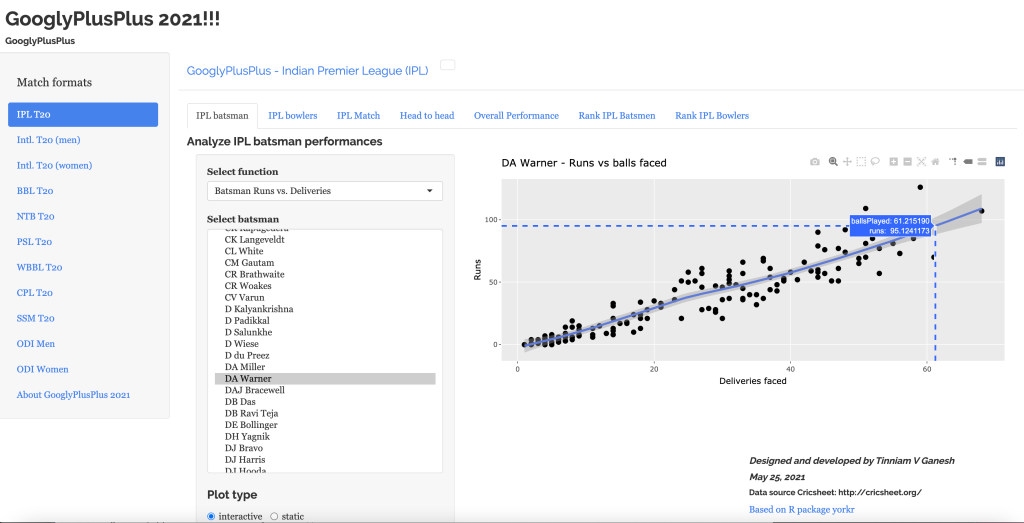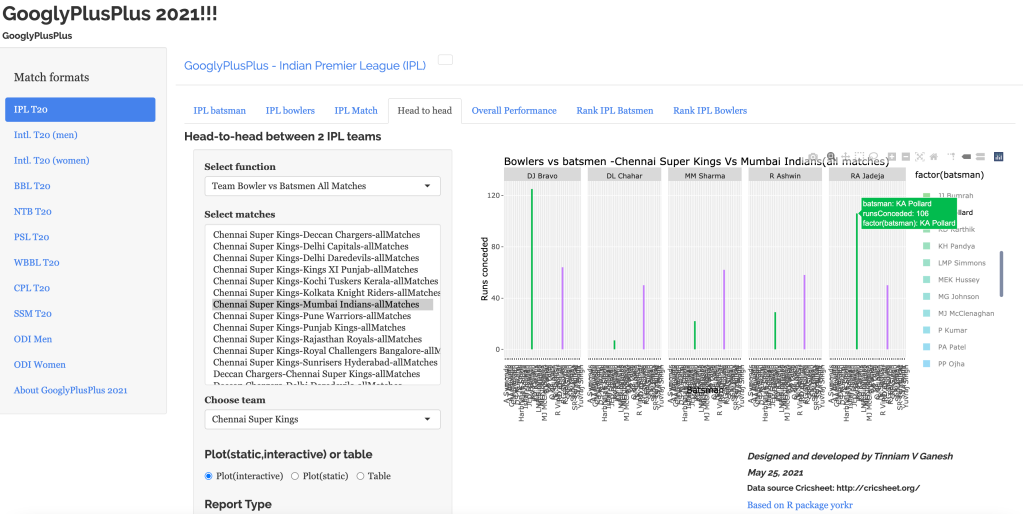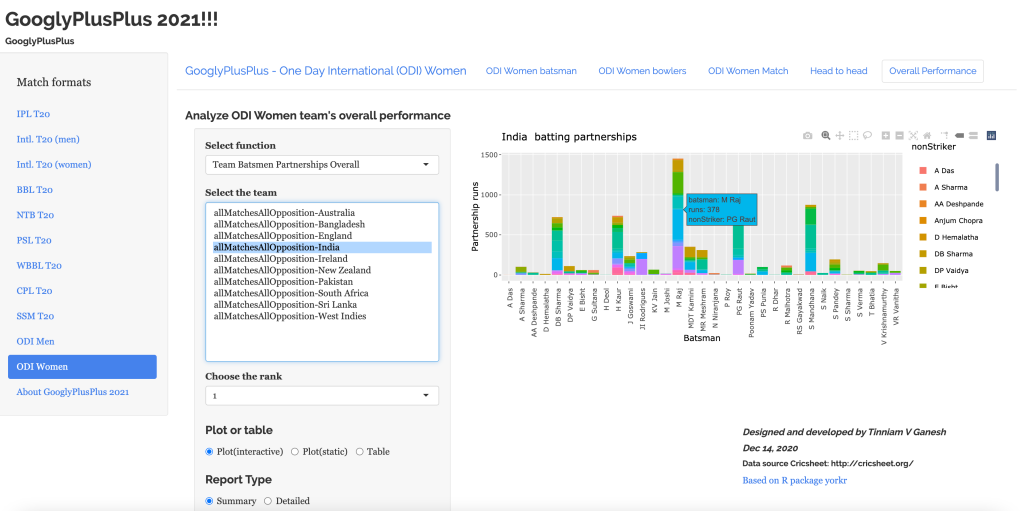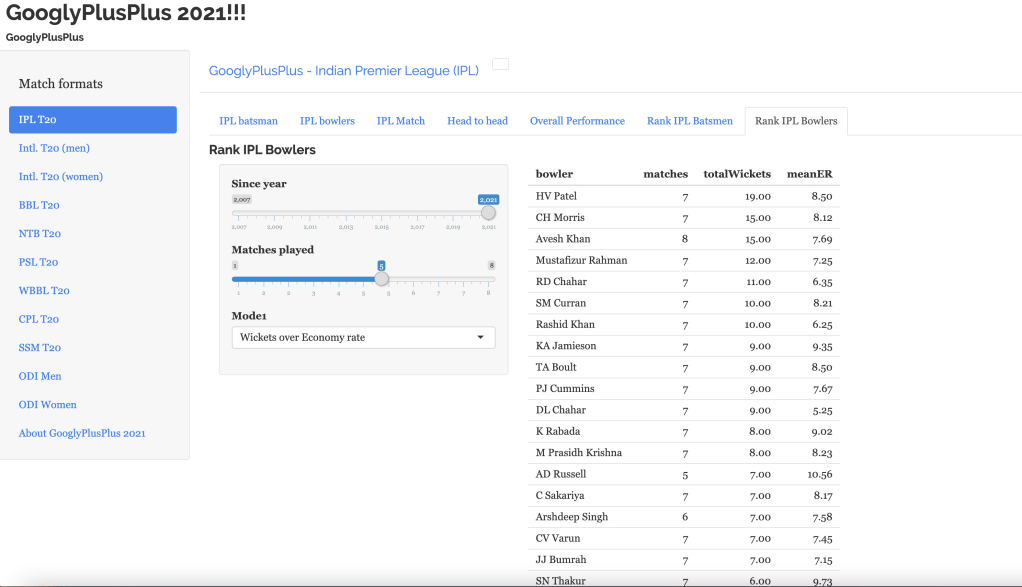1. Introduction
Often times before crucial matches, or in general, we would like to know the performance of a batsman against a bowler or vice-versa, but we may not have the data. We generally have data where different batsmen would have faced different sets of bowlers with certain performance data like ballsFaced, totalRuns, fours, sixes, strike rate and timesOut. Similarly different bowlers would have performance figures(deliveries, runsConceded, economyRate and wicketTaken) against different sets of batsmen. We will never have the data for all batsmen against all bowlers. However, it would be good estimate the performance of batsmen against a bowler, even though we do not have the performance data. This could be done using collaborative filtering which identifies and computes based on the similarity between batsmen vs bowlers & bowlers vs batsmen.
This post shows an approach whereby we can estimate a batsman’s performance against bowlers even though the batsman may not have faced those bowlers, based on his/her performance against other bowlers. It also estimates the performance of bowlers against batsmen using the same approach. This is based on the recommender algorithm which is used to recommend products to customers based on their rating on other products.
This idea came to me while generating the performance of batsmen vs bowlers & vice-versa for 2 IPL teams in this IPL 2022 with my Shiny app GooglyPlusPlus in the optimization tab, I found that there were some batsmen for which there was no data against certain bowlers, probably because they are playing for the first time in their team or because they were new (see picture below)

In the picture above there is no data for Dewald Brevis against Jasprit Bumrah and YS Chahal. Wouldn’t be great to estimate the performance of Brevis against Bumrah or vice-versa? Can we estimate this performance?
While pondering on this problem, I realized that this problem formulation is similar to the problem formulation for the famous Netflix movie recommendation problem, in which user’s ratings for certain movies are known and based on these ratings, the recommender engine can generate ratings for movies not yet seen.
This post estimates a player’s (batsman/bowler) using the recommender engine This post is based on R package recommenderlab
“Michael Hahsler (2021). recommenderlab: Lab for Developing and Testing Recommender Algorithms. R package version 0.2-7. https://github.com/mhahsler/recommenderlab”
Note 1: Thw data for this analysis is taken from Cricsheet after being processed by my R package yorkr.
You can also read this post in RPubs at Player Performance Estimation using AI Collaborative Filtering
A PDF copy of this post is available at Player Performance Estimation using AI Collaborative Filtering.pdf
You can download this R Markdown file and the associated data and perform the analysis yourself using any other recommender engine from Github at playerPerformanceEstimation
Problem statement
In the table below we see a set of bowlers vs a set of batsmen and the number of times the bowlers got these batsmen out.
By knowing the performance of the bowlers against some of the batsmen we can use collaborative filter to determine the missing values. This is done using the recommender engine.
The Recommender Engine works as follows. Let us say that there are feature vectors ,
and
for the 3 bowlers which identify the characteristics of these bowlers (“fast”, “lateral drift through the air”, “movement off the pitch”). Let each batsman be identified by parameter vectors
,
and so on
For e.g. consider the following table

Then by assuming an initial estimate for the parameter vector and the feature vector xx we can formulate this as an optimization problem which tries to minimize the error for
This can work very well as the algorithm can determine features which cannot be captured. So for e.g. some particular bowler may have very impressive figures. This could be due to some aspect of the bowling which cannot be captured by the data for e.g. let’s say the bowler uses the ‘scrambled seam’ when he is most effective, with a slightly different arc to the flight. Though the algorithm cannot identify the feature as we know it, but the ML algorithm should pick up intricacies which cannot be captured in data.
Hence the algorithm can be quite effective.
Note: The recommender lab performance is not very good and the Mean Square Error is quite high. Also, the ROC and AUC curves show that not in aLL cases the algorithm is doing a clean job of separating the True positives (TPR) from the False Positives (FPR)
Note: This is similar to the recommendation problem

The collaborative optimization object can be considered as a minimization of both and the features x and can be written as
J(,
}= 1/2
The collaborative filtering algorithm can be summarized as follows
- Initialize
,
…
and the set of features be
,
, … ,
to small random values
- Minimize J(
,
…
,
,
, … ,
) using gradient descent. For every
j=1,2, …, i= 1,2,..,
:=
–
(
)
–
&:=
–
(
- Hence for a batsman with parameters
and a bowler with (learned) features x, predict the “times out” for the player where the value is not known using
The above derivation for the recommender problem is taken from Machine Learning by Prof Andrew Ng at Coursera from the lecture Collaborative filtering
There are 2 main types of Collaborative Filtering(CF) approaches
- User based Collaborative Filtering User-based CF is a memory-based algorithm which tries to mimics word-of-mouth by analyzing rating data from many individuals. The assumption is that users with similar preferences will rate items similarly.
- Item based Collaborative Filtering Item-based CF is a model-based approach which produces recommendations based on the relationship between items inferred from the rating matrix. The assumption behind this approach is that users will prefer items that are similar to other items they like.
1a. A note on ROC and Precision-Recall curves
A small note on interpreting ROC & Precision-Recall curves in the post below
ROC Curve: The ROC curve plots the True Positive Rate (TPR) against the False Positive Rate (FPR). Ideally the TPR should increase faster than the FPR and the AUC (area under the curve) should be close to 1

Precision-Recall: The precision-recall curve shows the tradeoff between precision and recall for different threshold. A high area under the curve represents both high recall and high precision, where high precision relates to a low false positive rate, and high recall relates to a low false negative rate

library(reshape2)
library(dplyr)
library(ggplot2)
library(recommenderlab)
library(tidyr)
load("recom_data/batsmenVsBowler20_22.rdata")
2. Define recommender lab helper functions
Helper functions for the RMarkdown notebook are created
- eval – Gives details of RMSE, MSE and MAE of ML algorithm
- evalRecomMethods – Evaluates different recommender methods and plot the ROC and Precision-Recall curves
# This function returns the error for the chosen algorithm and also predicts the estimates
# for the given data
eval <- function(data, train1, k1,given1,goodRating1,recomType1="UBCF"){
set.seed(2022)
e<- evaluationScheme(data,
method = "split",
train = train1,
k = k1,
given = given1,
goodRating = goodRating1)
r1 <- Recommender(getData(e, "train"), recomType1)
print(r1)
p1 <- predict(r1, getData(e, "known"), type="ratings")
print(p1)
error = calcPredictionAccuracy(p1, getData(e, "unknown"))
print(error)
p2 <- predict(r1, data, type="ratingMatrix")
p2
}
# This function will evaluate the different recommender algorithms and plot the AUC and ROC curves
evalRecomMethods <- function(data,k1,given1,goodRating1){
set.seed(2022)
e<- evaluationScheme(data,
method = "cross",
k = k1,
given = given1,
goodRating = goodRating1)
models_to_evaluate <- list(
`IBCF Cosinus` = list(name = "IBCF",
param = list(method = "cosine")),
`IBCF Pearson` = list(name = "IBCF",
param = list(method = "pearson")),
`UBCF Cosinus` = list(name = "UBCF",
param = list(method = "cosine")),
`UBCF Pearson` = list(name = "UBCF",
param = list(method = "pearson")),
`Zufälliger Vorschlag` = list(name = "RANDOM", param=NULL)
)
n_recommendations <- c(1, 5, seq(10, 100, 10))
list_results <- evaluate(x = e,
method = models_to_evaluate,
n = n_recommendations)
plot(list_results, annotate=c(1,3), legend="bottomright")
plot(list_results, "prec/rec", annotate=3, legend="topleft")
}
3. Batsman performance estimation
The section below regenerates the performance for batsmen based on incomplete data for the different fields in the data frame namely balls faced, fours, sixes, strike rate, times out. The recommender lab allows one to test several different algorithms all at once namely
- User based – Cosine similarity method, Pearson similarity
- Item based – Cosine similarity method, Pearson similarity
- Popular
- Random
- SVD and a few others
3a. Batting dataframe
head(df)
## batsman1 bowler1 ballsFaced totalRuns fours sixes SR timesOut
## 1 A Badoni A Mishra 0 0 0 0 NaN 0
## 2 A Badoni A Nortje 0 0 0 0 NaN 0
## 3 A Badoni A Zampa 0 0 0 0 NaN 0
## 4 A Badoni Abdul Samad 0 0 0 0 NaN 0
## 5 A Badoni Abhishek Sharma 0 0 0 0 NaN 0
## 6 A Badoni AD Russell 0 0 0 0 NaN 0
3b Data set and data preparation
For this analysis the data from Cricsheet has been processed using my R package yorkr to obtain the following 2 data sets – batsmenVsBowler – This dataset will contain the performance of the batsmen against the bowler and will capture a) ballsFaced b) totalRuns c) Fours d) Sixes e) SR f) timesOut – bowlerVsBatsmen – This data set will contain the performance of the bowler against the difference batsmen and will include a) deliveries b) runsConceded c) EconomyRate d) wicketsTaken
Obviously many rows/columns will be empty
This is a large data set and hence I have filtered for the period > Jan 2020 and < Dec 2022 which gives 2 datasets a) batsmanVsBowler20_22.rdata b) bowlerVsBatsman20_22.rdata
I also have 2 other datasets of all batsmen and bowlers in these 2 dataset in the files c) all-batsmen20_22.rds d) all-bowlers20_22.rds
You can download the data and this RMarkdown notebook from Github at PlayerPerformanceEstimation
Feel free to download and analyze the data and use any recommendation engine you choose
3c. Exploratory analysis
Initially an exploratory analysis is done on the data
df3 <- select(df, batsman1,bowler1,timesOut)
df6 <- xtabs(timesOut ~ ., df3)
df7 <- as.data.frame.matrix(df6)
df8 <- data.matrix(df7)
df8[df8 == 0] <- NA
print(df8[1:10,1:10])
## A Mishra A Nortje A Zampa Abdul Samad Abhishek Sharma
## A Badoni NA NA NA NA NA
## A Manohar NA NA NA NA NA
## A Nortje NA NA NA NA NA
## AB de Villiers NA 4 3 NA NA
## Abdul Samad NA NA NA NA NA
## Abhishek Sharma NA NA NA NA NA
## AD Russell 1 NA NA NA NA
## AF Milne NA NA NA NA NA
## AJ Finch NA NA NA NA 3
## AJ Tye NA NA NA NA NA
## AD Russell AF Milne AJ Tye AK Markram Akash Deep
## A Badoni NA NA NA NA NA
## A Manohar NA NA NA NA NA
## A Nortje NA NA NA NA NA
## AB de Villiers 3 NA 3 NA NA
## Abdul Samad NA NA NA NA NA
## Abhishek Sharma NA NA NA NA NA
## AD Russell NA NA 6 NA NA
## AF Milne NA NA NA NA NA
## AJ Finch NA NA NA NA NA
## AJ Tye NA NA NA NA NA
The dots below represent data for which there is no performance data. These cells need to be estimated by the algorithm
set.seed(2022)
r <- as(df8,"realRatingMatrix")
getRatingMatrix(r)[1:15,1:15]
## 15 x 15 sparse Matrix of class "dgCMatrix"
## [[ suppressing 15 column names 'A Mishra', 'A Nortje', 'A Zampa' ... ]]
##
## A Badoni . . . . . . . . . . . . . . .
## A Manohar . . . . . . . . . . . . . . .
## A Nortje . . . . . . . . . . . . . . .
## AB de Villiers . 4 3 . . 3 . 3 . . . 4 3 . .
## Abdul Samad . . . . . . . . . . . . . . .
## Abhishek Sharma . . . . . . . . . . . 1 . . .
## AD Russell 1 . . . . . . 6 . . . 3 3 3 .
## AF Milne . . . . . . . . . . . . . . .
## AJ Finch . . . . 3 . . . . . . 1 . . .
## AJ Tye . . . . . . . . . . . 1 . . .
## AK Markram . . . 3 . . . . . . . . . . .
## AM Rahane 9 . . . . 3 . 3 . . . 3 3 . .
## Anmolpreet Singh . . . . . . . . . . . . . . .
## Anuj Rawat . . . . . . . . . . . . . . .
## AR Patel . . . . . . . 1 . . . . . . .
r0=r[(rowCounts(r) > 10),]
getRatingMatrix(r0)[1:15,1:15]
## 15 x 15 sparse Matrix of class "dgCMatrix"
## [[ suppressing 15 column names 'A Mishra', 'A Nortje', 'A Zampa' ... ]]
##
## AB de Villiers . 4 3 . . 3 . 3 . . . 4 3 . .
## Abdul Samad . . . . . . . . . . . . . . .
## Abhishek Sharma . . . . . . . . . . . 1 . . .
## AD Russell 1 . . . . . . 6 . . . 3 3 3 .
## AJ Finch . . . . 3 . . . . . . 1 . . .
## AM Rahane 9 . . . . 3 . 3 . . . 3 3 . .
## AR Patel . . . . . . . 1 . . . . . . .
## AT Rayudu 2 . . . . . 1 . . . . 3 . . .
## B Kumar 3 . 3 . . . . . . . . . . 3 .
## BA Stokes . . . . . . 3 4 . . . 3 . . .
## CA Lynn . . . . . . . 9 . . . 3 . . .
## CH Gayle . . . . . 6 . 3 . . . 6 . . .
## CH Morris . 3 . . . . . . . . . 3 . . .
## D Padikkal . 4 . . . 3 . . . . . . 3 . .
## DA Miller . . . . . 3 . . . . . 3 . . .
# Get the summary of the data
summary(getRatings(r0))
## Min. 1st Qu. Median Mean 3rd Qu. Max.
## 1.000 3.000 3.000 3.463 4.000 21.000
# Normalize the data
r0_m <- normalize(r0)
getRatingMatrix(r0_m)[1:15,1:15]
## 15 x 15 sparse Matrix of class "dgCMatrix"
## [[ suppressing 15 column names 'A Mishra', 'A Nortje', 'A Zampa' ... ]]
##
## AB de Villiers . -0.7857143 -1.7857143 . . -1.7857143
## Abdul Samad . . . . . .
## Abhishek Sharma . . . . . .
## AD Russell -2.6562500 . . . . .
## AJ Finch . . . . -0.03125 .
## AM Rahane 4.6041667 . . . . -1.3958333
## AR Patel . . . . . .
## AT Rayudu -2.1363636 . . . . .
## B Kumar 0.3636364 . 0.3636364 . . .
## BA Stokes . . . . . .
## CA Lynn . . . . . .
## CH Gayle . . . . . 1.5476190
## CH Morris . 0.3500000 . . . .
## D Padikkal . 0.6250000 . . . -0.3750000
## DA Miller . . . . . -0.7037037
##
## AB de Villiers . -1.7857143 . . . -0.7857143 -1.785714 . .
## Abdul Samad . . . . . . . . .
## Abhishek Sharma . . . . . -1.6000000 . . .
## AD Russell . 2.3437500 . . . -0.6562500 -0.656250 -0.6562500 .
## AJ Finch . . . . . -2.0312500 . . .
## AM Rahane . -1.3958333 . . . -1.3958333 -1.395833 . .
## AR Patel . -2.3333333 . . . . . . .
## AT Rayudu -3.1363636 . . . . -1.1363636 . . .
## B Kumar . . . . . . . 0.3636364 .
## BA Stokes -0.6086957 0.3913043 . . . -0.6086957 . . .
## CA Lynn . 5.3200000 . . . -0.6800000 . . .
## CH Gayle . -1.4523810 . . . 1.5476190 . . .
## CH Morris . . . . . 0.3500000 . . .
## D Padikkal . . . . . . -0.375000 . .
## DA Miller . . . . . -0.7037037 . . .
4. Create a visual representation of the rating data before and after the normalization
The histograms show the bias in the data is removed after normalization
r0=r[(m=rowCounts(r) > 10),]
getRatingMatrix(r0)[1:15,1:10]
## 15 x 10 sparse Matrix of class "dgCMatrix"
## [[ suppressing 10 column names 'A Mishra', 'A Nortje', 'A Zampa' ... ]]
##
## AB de Villiers . 4 3 . . 3 . 3 . .
## Abdul Samad . . . . . . . . . .
## Abhishek Sharma . . . . . . . . . .
## AD Russell 1 . . . . . . 6 . .
## AJ Finch . . . . 3 . . . . .
## AM Rahane 9 . . . . 3 . 3 . .
## AR Patel . . . . . . . 1 . .
## AT Rayudu 2 . . . . . 1 . . .
## B Kumar 3 . 3 . . . . . . .
## BA Stokes . . . . . . 3 4 . .
## CA Lynn . . . . . . . 9 . .
## CH Gayle . . . . . 6 . 3 . .
## CH Morris . 3 . . . . . . . .
## D Padikkal . 4 . . . 3 . . . .
## DA Miller . . . . . 3 . . . .
#Plot ratings
image(r0, main = "Raw Ratings")

#Plot normalized ratings
r0_m <- normalize(r0)
getRatingMatrix(r0_m)[1:15,1:15]
## 15 x 15 sparse Matrix of class "dgCMatrix"
## [[ suppressing 15 column names 'A Mishra', 'A Nortje', 'A Zampa' ... ]]
##
## AB de Villiers . -0.7857143 -1.7857143 . . -1.7857143
## Abdul Samad . . . . . .
## Abhishek Sharma . . . . . .
## AD Russell -2.6562500 . . . . .
## AJ Finch . . . . -0.03125 .
## AM Rahane 4.6041667 . . . . -1.3958333
## AR Patel . . . . . .
## AT Rayudu -2.1363636 . . . . .
## B Kumar 0.3636364 . 0.3636364 . . .
## BA Stokes . . . . . .
## CA Lynn . . . . . .
## CH Gayle . . . . . 1.5476190
## CH Morris . 0.3500000 . . . .
## D Padikkal . 0.6250000 . . . -0.3750000
## DA Miller . . . . . -0.7037037
##
## AB de Villiers . -1.7857143 . . . -0.7857143 -1.785714 . .
## Abdul Samad . . . . . . . . .
## Abhishek Sharma . . . . . -1.6000000 . . .
## AD Russell . 2.3437500 . . . -0.6562500 -0.656250 -0.6562500 .
## AJ Finch . . . . . -2.0312500 . . .
## AM Rahane . -1.3958333 . . . -1.3958333 -1.395833 . .
## AR Patel . -2.3333333 . . . . . . .
## AT Rayudu -3.1363636 . . . . -1.1363636 . . .
## B Kumar . . . . . . . 0.3636364 .
## BA Stokes -0.6086957 0.3913043 . . . -0.6086957 . . .
## CA Lynn . 5.3200000 . . . -0.6800000 . . .
## CH Gayle . -1.4523810 . . . 1.5476190 . . .
## CH Morris . . . . . 0.3500000 . . .
## D Padikkal . . . . . . -0.375000 . .
## DA Miller . . . . . -0.7037037 . . .
image(r0_m, main = "Normalized Ratings")

set.seed(1234)
hist(getRatings(r0), breaks=25)

hist(getRatings(r0_m), breaks=25)

4a. Data for analysis
The data frame of the batsman vs bowlers from the period 2020 -2022 is read as a dataframe. To remove rows with very low number of ratings(timesOut, SR, Fours, Sixes etc), the rows are filtered so that there are at least more 10 values in the row. For the player estimation the dataframe is converted into a wide-format as a matrix (m x n) of batsman x bowler with each of the columns of the dataframe i.e. timesOut, SR, fours or sixes. These different matrices can be considered as a rating matrix for estimation.
A similar approach is taken for estimating bowler performance. Here a wide form matrix (m x n) of bowler x batsman is created for each of the columns of deliveries, runsConceded, ER, wicketsTaken
5. Batsman’s times Out
The code below estimates the number of times the batsmen would lose his/her wicket to the bowler. As discussed in the algorithm above, the recommendation engine will make an initial estimate features for the bowler and an initial estimate for the parameter vector for the batsmen. Then using gradient descent the recommender engine will determine the feature and parameter values such that the over Mean Squared Error is minimum
From the plot for the different algorithms it can be seen that UBCF performs the best. However the AUC & ROC curves are not optimal and the AUC> 0.5
df3 <- select(df, batsman1,bowler1,timesOut)
df6 <- xtabs(timesOut ~ ., df3)
df7 <- as.data.frame.matrix(df6)
df8 <- data.matrix(df7)
df8[df8 == 0] <- NA
r <- as(df8,"realRatingMatrix")
# Filter only rows where the row count is > 10
r0=r[(rowCounts(r) > 10),]
getRatingMatrix(r0)[1:10,1:10]
## 10 x 10 sparse Matrix of class "dgCMatrix"
## [[ suppressing 10 column names 'A Mishra', 'A Nortje', 'A Zampa' ... ]]
##
## AB de Villiers . 4 3 . . 3 . 3 . .
## Abdul Samad . . . . . . . . . .
## Abhishek Sharma . . . . . . . . . .
## AD Russell 1 . . . . . . 6 . .
## AJ Finch . . . . 3 . . . . .
## AM Rahane 9 . . . . 3 . 3 . .
## AR Patel . . . . . . . 1 . .
## AT Rayudu 2 . . . . . 1 . . .
## B Kumar 3 . 3 . . . . . . .
## BA Stokes . . . . . . 3 4 . .
summary(getRatings(r0))
## Min. 1st Qu. Median Mean 3rd Qu. Max.
## 1.000 3.000 3.000 3.463 4.000 21.000
# Evaluate the different plotting methods
evalRecomMethods(r0[1:dim(r0)[1]],k1=5,given=7,goodRating1=median(getRatings(r0)))


#Evaluate the error
a=eval(r0[1:dim(r0)[1]],0.8,k1=5,given1=7,goodRating1=median(getRatings(r0)),"UBCF")
## Recommender of type 'UBCF' for 'realRatingMatrix'
## learned using 70 users.
## 18 x 145 rating matrix of class 'realRatingMatrix' with 1755 ratings.
## RMSE MSE MAE
## 2.069027 4.280872 1.496388
b=round(as(a,"matrix")[1:10,1:10])
c <- as(b,"realRatingMatrix")
m=as(c,"data.frame")
names(m) =c("batsman","bowler","TimesOut")
6. Batsman’s Strike rate
This section deals with the Strike rate of batsmen versus bowlers and estimates the values for those where the data is incomplete using UBCF method.
Even here all the algorithms do not perform too efficiently. I did try out a few variations but could not lower the error (suggestions welcome!!)
df3 <- select(df, batsman1,bowler1,SR)
df6 <- xtabs(SR ~ ., df3)
df7 <- as.data.frame.matrix(df6)
df8 <- data.matrix(df7)
df8[df8 == 0] <- NA
r <- as(df8,"realRatingMatrix")
r0=r[(rowCounts(r) > 10),]
getRatingMatrix(r0)[1:10,1:10]
## 10 x 10 sparse Matrix of class "dgCMatrix"
## [[ suppressing 10 column names 'A Mishra', 'A Nortje', 'A Zampa' ... ]]
##
## AB de Villiers 96.8254 171.4286 33.33333 . 66.66667 223.07692 .
## Abdul Samad . 228.0000 . . . 100.00000 .
## Abhishek Sharma 150.0000 . . . . 66.66667 .
## AD Russell 111.4286 . . . . . .
## AJ Finch 250.0000 116.6667 . . 50.00000 85.71429 112.5000
## AJ Tye . . . . . . 100.0000
## AK Markram . . . 50 . . .
## AM Rahane 121.1111 . . . . 113.82979 117.9487
## AR Patel 183.3333 . 200.00000 . . 433.33333 .
## AT Rayudu 126.5432 200.0000 122.22222 . . 105.55556 .
##
## AB de Villiers 109.52381 . .
## Abdul Samad . . .
## Abhishek Sharma . . .
## AD Russell 195.45455 . .
## AJ Finch . . .
## AJ Tye . . .
## AK Markram . . .
## AM Rahane 33.33333 . 200
## AR Patel 171.42857 . .
## AT Rayudu 204.76190 . .
summary(getRatings(r0))
## Min. 1st Qu. Median Mean 3rd Qu. Max.
## 5.882 85.714 116.667 128.529 160.606 600.000
evalRecomMethods(r0[1:dim(r0)[1]],k1=5,given=7,goodRating1=median(getRatings(r0)))


a=eval(r0[1:dim(r0)[1]],0.8, k1=5,given1=7,goodRating1=median(getRatings(r0)),"UBCF")
## Recommender of type 'UBCF' for 'realRatingMatrix'
## learned using 105 users.
## 27 x 145 rating matrix of class 'realRatingMatrix' with 3220 ratings.
## RMSE MSE MAE
## 77.71979 6040.36508 58.58484
b=round(as(a,"matrix")[1:10,1:10])
c <- as(b,"realRatingMatrix")
n=as(c,"data.frame")
names(n) =c("batsman","bowler","SR")
7. Batsman’s Sixes
The snippet of code estimes the sixes of the batsman against bowlers. The ROC and AUC curve for UBCF looks a lot better here, as it significantly greater than 0.5
df3 <- select(df, batsman1,bowler1,sixes)
df6 <- xtabs(sixes ~ ., df3)
df7 <- as.data.frame.matrix(df6)
df8 <- data.matrix(df7)
df8[df8 == 0] <- NA
r <- as(df8,"realRatingMatrix")
r0=r[(rowCounts(r) > 10),]
getRatingMatrix(r0)[1:10,1:10]
## 10 x 10 sparse Matrix of class "dgCMatrix"
## [[ suppressing 10 column names 'A Mishra', 'A Nortje', 'A Zampa' ... ]]
##
## AB de Villiers 3 3 . . . 18 . 3 . .
## AD Russell 3 . . . . . . 12 . .
## AJ Finch 2 . . . . . . . . .
## AM Rahane 7 . . . . 3 1 . . .
## AR Patel 4 . 3 . . 6 . 1 . .
## AT Rayudu 5 2 . . . . . 1 . .
## BA Stokes . . . . . . . . . .
## CA Lynn . . . . . . . 9 . .
## CH Gayle 17 . . . . 17 . . . .
## CH Morris . . 3 . . . . . . .
summary(getRatings(r0))
## Min. 1st Qu. Median Mean 3rd Qu. Max.
## 1.00 3.00 3.00 4.68 6.00 33.00
evalRecomMethods(r0[1:dim(r0)[1]],k1=5,given=7,goodRating1=median(getRatings(r0)))
## Timing stopped at: 0.003 0 0.002


a=eval(r0[1:dim(r0)[1]],0.8, k1=5,given1=7,goodRating1=median(getRatings(r0)),"UBCF")
## Recommender of type 'UBCF' for 'realRatingMatrix'
## learned using 52 users.
## 14 x 145 rating matrix of class 'realRatingMatrix' with 1634 ratings.
## RMSE MSE MAE
## 3.529922 12.460350 2.532122
b=round(as(a,"matrix")[1:10,1:10])
c <- as(b,"realRatingMatrix")
o=as(c,"data.frame")
names(o) =c("batsman","bowler","Sixes")
8. Batsman’s Fours
The code below estimates 4s for the batsmen
df3 <- select(df, batsman1,bowler1,fours)
df6 <- xtabs(fours ~ ., df3)
df7 <- as.data.frame.matrix(df6)
df8 <- data.matrix(df7)
df8[df8 == 0] <- NA
r <- as(df8,"realRatingMatrix")
r0=r[(rowCounts(r) > 10),]
getRatingMatrix(r0)[1:10,1:10]
## 10 x 10 sparse Matrix of class "dgCMatrix"
## [[ suppressing 10 column names 'A Mishra', 'A Nortje', 'A Zampa' ... ]]
##
## AB de Villiers . 1 . . . 24 . 3 . .
## Abhishek Sharma . . . . . . . . . .
## AD Russell 1 . . . . . . 9 . .
## AJ Finch . 1 . . . 3 2 . . .
## AK Markram . . . . . . . . . .
## AM Rahane 11 . . . . 8 7 . . 3
## AR Patel . . . . . . . 3 . .
## AT Rayudu 11 2 3 . . 6 . 6 . .
## BA Stokes 1 . . . . . . . . .
## CA Lynn . . . . . . . 6 . .
summary(getRatings(r0))
## Min. 1st Qu. Median Mean 3rd Qu. Max.
## 1.000 3.000 4.000 6.339 9.000 55.000
evalRecomMethods(r0[1:dim(r0)[1]],k1=5,given=7,goodRating1=median(getRatings(r0)))
## Timing stopped at: 0.008 0 0.008
## Warning in .local(x, method, ...):
## Recommender 'UBCF Pearson' has failed and has been removed from the results!


a=eval(r0[1:dim(r0)[1]],0.8, k1=5,given1=7,goodRating1=median(getRatings(r0)),"UBCF")
## Recommender of type 'UBCF' for 'realRatingMatrix'
## learned using 67 users.
## 17 x 145 rating matrix of class 'realRatingMatrix' with 2083 ratings.
## RMSE MSE MAE
## 5.486661 30.103447 4.060990
b=round(as(a,"matrix")[1:10,1:10])
c <- as(b,"realRatingMatrix")
p=as(c,"data.frame")
names(p) =c("batsman","bowler","Fours")
9. Batsman’s Total Runs
The code below estimates the total runs that would have scored by the batsman against different bowlers
df3 <- select(df, batsman1,bowler1,totalRuns)
df6 <- xtabs(totalRuns ~ ., df3)
df7 <- as.data.frame.matrix(df6)
df8 <- data.matrix(df7)
df8[df8 == 0] <- NA
r <- as(df8,"realRatingMatrix")
r0=r[(rowCounts(r) > 10),]
getRatingMatrix(r)[1:10,1:10]
## 10 x 10 sparse Matrix of class "dgCMatrix"
## [[ suppressing 10 column names 'A Mishra', 'A Nortje', 'A Zampa' ... ]]
##
## A Badoni . . . . . . . . . .
## A Manohar . . . . . . . . . .
## A Nortje . . . . . . . . . .
## AB de Villiers 61 36 3 . 6 261 . 69 . .
## Abdul Samad . 57 . . . 12 . . . .
## Abhishek Sharma 3 . . . . 6 . . . .
## AD Russell 39 . . . . . . 129 . .
## AF Milne . . . . . . . . . .
## AJ Finch 15 7 . . 3 18 9 . . .
## AJ Tye . . . . . . 4 . . .
summary(getRatings(r0))
## Min. 1st Qu. Median Mean 3rd Qu. Max.
## 1.00 9.00 24.00 41.36 54.00 452.00
evalRecomMethods(r0[1:dim(r0)[1]],k1=5,given1=7,goodRating1=median(getRatings(r0)))


a=eval(r0[1:dim(r0)[1]],0.8, k1=5,given1=7,goodRating1=median(getRatings(r0)),"UBCF")
## Recommender of type 'UBCF' for 'realRatingMatrix'
## learned using 105 users.
## 27 x 145 rating matrix of class 'realRatingMatrix' with 3256 ratings.
## RMSE MSE MAE
## 41.50985 1723.06788 29.52958
b=round(as(a,"matrix")[1:10,1:10])
c <- as(b,"realRatingMatrix")
q=as(c,"data.frame")
names(q) =c("batsman","bowler","TotalRuns")
10. Batsman’s Balls Faced
The snippet estimates the balls faced by batsmen versus bowlers
df3 <- select(df, batsman1,bowler1,ballsFaced)
df6 <- xtabs(ballsFaced ~ ., df3)
df7 <- as.data.frame.matrix(df6)
df8 <- data.matrix(df7)
df8[df8 == 0] <- NA
r <- as(df8,"realRatingMatrix")
r0=r[(rowCounts(r) > 10),]
getRatingMatrix(r)[1:10,1:10]
## 10 x 10 sparse Matrix of class "dgCMatrix"
## [[ suppressing 10 column names 'A Mishra', 'A Nortje', 'A Zampa' ... ]]
##
## A Badoni . . . . . . . . . .
## A Manohar . . . . . . . . . .
## A Nortje . . . . . . . . . .
## AB de Villiers 63 21 9 . 9 117 . 63 . .
## Abdul Samad . 25 . . . 12 . . . .
## Abhishek Sharma 2 . . . . 9 . . . .
## AD Russell 35 . . . . . . 66 . .
## AF Milne . . . . . . . . . .
## AJ Finch 6 6 . . 6 21 8 . . .
## AJ Tye . . . . . 9 4 . . .
summary(getRatings(r0))
## Min. 1st Qu. Median Mean 3rd Qu. Max.
## 1.00 9.00 18.00 30.21 39.00 384.00
evalRecomMethods(r0[1:dim(r0)[1]],k1=5,given=7,goodRating1=median(getRatings(r0)))


a=eval(r0[1:dim(r0)[1]],0.8, k1=5,given1=7,goodRating1=median(getRatings(r0)),"UBCF")
## Recommender of type 'UBCF' for 'realRatingMatrix'
## learned using 112 users.
## 28 x 145 rating matrix of class 'realRatingMatrix' with 3378 ratings.
## RMSE MSE MAE
## 33.91251 1150.05835 23.39439
b=round(as(a,"matrix")[1:10,1:10])
c <- as(b,"realRatingMatrix")
r=as(c,"data.frame")
names(r) =c("batsman","bowler","BallsFaced")
11. Generate the Batsmen Performance Estimate
This code generates the estimated dataframe with known and ‘predicted’ values
a1=merge(m,n,by=c("batsman","bowler"))
a2=merge(a1,o,by=c("batsman","bowler"))
a3=merge(a2,p,by=c("batsman","bowler"))
a4=merge(a3,q,by=c("batsman","bowler"))
a5=merge(a4,r,by=c("batsman","bowler"))
a6= select(a5, batsman,bowler,BallsFaced,TotalRuns,Fours, Sixes, SR,TimesOut)
head(a6)
## batsman bowler BallsFaced TotalRuns Fours Sixes SR TimesOut
## 1 AB de Villiers A Mishra 94 124 7 5 144 5
## 2 AB de Villiers A Nortje 26 42 4 3 148 3
## 3 AB de Villiers A Zampa 28 42 5 7 106 4
## 4 AB de Villiers Abhishek Sharma 22 28 0 10 136 5
## 5 AB de Villiers AD Russell 70 135 14 12 207 4
## 6 AB de Villiers AF Milne 31 45 6 6 130 3
12. Bowler analysis
Just like the batsman performance estimation we can consider the bowler’s performances also for estimation. Consider the following table

As in the batsman analysis, for every batsman a set of features like (“strong backfoot player”, “360 degree player”,“Power hitter”) can be estimated with a set of initial values. Also every bowler will have an associated parameter vector θθ. Different bowlers will have performance data for different set of batsmen. Based on the initial estimate of the features and the parameters, gradient descent can be used to minimize actual values {for e.g. wicketsTaken(ratings)}.
load("recom_data/bowlerVsBatsman20_22.rdata")
12a. Bowler dataframe
Inspecting the bowler dataframe
head(df2)
## bowler1 batsman1 balls runsConceded ER wicketTaken
## 1 A Mishra A Badoni 0 0 0.000000 0
## 2 A Mishra A Manohar 0 0 0.000000 0
## 3 A Mishra A Nortje 0 0 0.000000 0
## 4 A Mishra AB de Villiers 63 61 5.809524 0
## 5 A Mishra Abdul Samad 0 0 0.000000 0
## 6 A Mishra Abhishek Sharma 2 3 9.000000 0
names(df2)
## [1] "bowler1" "batsman1" "balls" "runsConceded" "ER"
## [6] "wicketTaken"
13. Balls bowled by bowler
The below section estimates the balls bowled for each bowler. We can see that UBCF Pearson and UBCF Cosine both perform well
df3 <- select(df2, bowler1,batsman1,balls)
df6 <- xtabs(balls ~ ., df3)
df7 <- as.data.frame.matrix(df6)
df8 <- data.matrix(df7)
df8[df8 == 0] <- NA
r <- as(df8,"realRatingMatrix")
r0=r[(rowCounts(r) > 10),]
getRatingMatrix(r0)[1:10,1:10]
## 10 x 10 sparse Matrix of class "dgCMatrix"
## [[ suppressing 10 column names 'A Badoni', 'A Manohar', 'A Nortje' ... ]]
##
## A Mishra . . . 63 . 2 35 . 6 .
## A Nortje . . . 21 25 . . . 6 .
## A Zampa . . . 9 . . . . . .
## Abhishek Sharma . . . 9 . . . . 6 .
## AD Russell . . . 117 12 9 . . 21 9
## AF Milne . . . . . . . . 8 4
## AJ Tye . . . 63 . . 66 . . .
## Akash Deep . . . . . . . . . .
## AR Patel . . . 188 5 1 84 . 29 5
## Arshdeep Singh . . . 6 6 24 18 . 12 .
summary(getRatings(r0))
## Min. 1st Qu. Median Mean 3rd Qu. Max.
## 1.00 9.00 18.00 29.61 36.00 384.00
evalRecomMethods(r0[1:dim(r0)[1]],k1=5,given=7,goodRating1=median(getRatings(r0)))


a=eval(r0[1:dim(r0)[1]],0.8,k1=5,given1=7,goodRating1=median(getRatings(r0)),"UBCF")
## Recommender of type 'UBCF' for 'realRatingMatrix'
## learned using 96 users.
## 24 x 195 rating matrix of class 'realRatingMatrix' with 3954 ratings.
## RMSE MSE MAE
## 30.72284 943.89294 19.89204
b=round(as(a,"matrix")[1:10,1:10])
c <- as(b,"realRatingMatrix")
s=as(c,"data.frame")
names(s) =c("bowler","batsman","BallsBowled")
14. Runs conceded by bowler
This section estimates the runs conceded by the bowler. The UBCF Cosinus algorithm performs the best with TPR increasing fastewr than FPR
df3 <- select(df2, bowler1,batsman1,runsConceded)
df6 <- xtabs(runsConceded ~ ., df3)
df7 <- as.data.frame.matrix(df6)
df8 <- data.matrix(df7)
df8[df8 == 0] <- NA
r <- as(df8,"realRatingMatrix")
r0=r[(rowCounts(r) > 10),]
getRatingMatrix(r0)[1:10,1:10]
## 10 x 10 sparse Matrix of class "dgCMatrix"
## [[ suppressing 10 column names 'A Badoni', 'A Manohar', 'A Nortje' ... ]]
##
## A Mishra . . . 61 . 3 41 . 15 .
## A Nortje . . . 36 57 . . . 8 .
## A Zampa . . . 3 . . . . . .
## Abhishek Sharma . . . 6 . . . . 3 .
## AD Russell . . . 276 12 6 . . 21 .
## AF Milne . . . . . . . . 10 4
## AJ Tye . . . 69 . . 138 . . .
## Akash Deep . . . . . . . . . .
## AR Patel . . . 205 5 . 165 . 33 13
## Arshdeep Singh . . . 18 3 51 51 . 6 .
summary(getRatings(r0))
## Min. 1st Qu. Median Mean 3rd Qu. Max.
## 1.00 9.00 24.00 41.34 54.00 458.00
evalRecomMethods(r0[1:dim(r0)[1]],k1=5,given=7,goodRating1=median(getRatings(r0)))
## Timing stopped at: 0.004 0 0.004
## Warning in .local(x, method, ...):
## Recommender 'UBCF Pearson' has failed and has been removed from the results!


a=eval(r0[1:dim(r0)[1]],0.8,k1=5,given1=7,goodRating1=median(getRatings(r0)),"UBCF")
## Recommender of type 'UBCF' for 'realRatingMatrix'
## learned using 95 users.
## 24 x 195 rating matrix of class 'realRatingMatrix' with 3820 ratings.
## RMSE MSE MAE
## 43.16674 1863.36749 30.32709
b=round(as(a,"matrix")[1:10,1:10])
c <- as(b,"realRatingMatrix")
t=as(c,"data.frame")
names(t) =c("bowler","batsman","RunsConceded")
15. Economy Rate of the bowler
This section computes the economy rate of the bowler. The performance is not all that good
df3 <- select(df2, bowler1,batsman1,ER)
df6 <- xtabs(ER ~ ., df3)
df7 <- as.data.frame.matrix(df6)
df8 <- data.matrix(df7)
df8[df8 == 0] <- NA
r <- as(df8,"realRatingMatrix")
r0=r[(rowCounts(r) > 10),]
getRatingMatrix(r0)[1:10,1:10]
## 10 x 10 sparse Matrix of class "dgCMatrix"
## [[ suppressing 10 column names 'A Badoni', 'A Manohar', 'A Nortje' ... ]]
##
## A Mishra . . . 5.809524 . 9.00 7.028571 . 15.000000 .
## A Nortje . . . 10.285714 13.68 . . . 8.000000 .
## A Zampa . . . 2.000000 . . . . . .
## Abhishek Sharma . . . 4.000000 . . . . 3.000000 .
## AD Russell . . . 14.153846 6.00 4.00 . . 6.000000 .
## AF Milne . . . . . . . . 7.500000 6.0
## AJ Tye . . . 6.571429 . . 12.545455 . . .
## Akash Deep . . . . . . . . . .
## AR Patel . . . 6.542553 6.00 . 11.785714 . 6.827586 15.6
## Arshdeep Singh . . . 18.000000 3.00 12.75 17.000000 . 3.000000 .
summary(getRatings(r0))
## Min. 1st Qu. Median Mean 3rd Qu. Max.
## 0.3529 5.2500 7.1126 7.8139 9.8000 36.0000
evalRecomMethods(r0[1:dim(r0)[1]],k1=5,given=7,goodRating1=median(getRatings(r0)))
## Timing stopped at: 0.003 0 0.004
## Warning in .local(x, method, ...):
## Recommender 'UBCF Pearson' has failed and has been removed from the results!


a=eval(r0[1:dim(r0)[1]],0.8,k1=5,given1=7,goodRating1=median(getRatings(r0)),"UBCF")
## Recommender of type 'UBCF' for 'realRatingMatrix'
## learned using 95 users.
## 24 x 195 rating matrix of class 'realRatingMatrix' with 3839 ratings.
## RMSE MSE MAE
## 4.380680 19.190356 3.316556
b=round(as(a,"matrix")[1:10,1:10])
c <- as(b,"realRatingMatrix")
u=as(c,"data.frame")
names(u) =c("bowler","batsman","EconomyRate")
16. Wickets Taken by bowler
The code below computes the wickets taken by the bowler versus different batsmen
df3 <- select(df2, bowler1,batsman1,wicketTaken)
df6 <- xtabs(wicketTaken ~ ., df3)
df7 <- as.data.frame.matrix(df6)
df8 <- data.matrix(df7)
df8[df8 == 0] <- NA
r <- as(df8,"realRatingMatrix")
r0=r[(rowCounts(r) > 10),]
getRatingMatrix(r0)[1:10,1:10]
## 10 x 10 sparse Matrix of class "dgCMatrix"
## [[ suppressing 10 column names 'A Badoni', 'A Manohar', 'A Nortje' ... ]]
##
## A Mishra . . . . . . 1 . . .
## A Nortje . . . 4 . . . . . .
## A Zampa . . . 3 . . . . . .
## AD Russell . . . 3 . . . . . .
## AJ Tye . . . 3 . . 6 . . .
## AR Patel . . . 4 . 1 3 . 1 1
## Arshdeep Singh . . . 3 . . 3 . . .
## AS Rajpoot . . . . . . 3 . . .
## Avesh Khan . . . . . . 1 . 3 .
## B Kumar . . . 9 . . 3 . 1 .
summary(getRatings(r0))
## Min. 1st Qu. Median Mean 3rd Qu. Max.
## 1.000 3.000 3.000 3.423 3.000 21.000
evalRecomMethods(r0[1:dim(r0)[1]],k1=5,given=7,goodRating1=median(getRatings(r0)))
## Timing stopped at: 0.003 0 0.003
## Warning in .local(x, method, ...):
## Recommender 'UBCF Pearson' has failed and has been removed from the results!


a=eval(r0[1:dim(r0)[1]],0.8,k1=5,given1=7,goodRating1=median(getRatings(r0)),"UBCF")
## Recommender of type 'UBCF' for 'realRatingMatrix'
## learned using 64 users.
## 16 x 195 rating matrix of class 'realRatingMatrix' with 1908 ratings.
## RMSE MSE MAE
## 2.672677 7.143203 1.956934
b=round(as(a,"matrix")[1:10,1:10])
c <- as(b,"realRatingMatrix")
v=as(c,"data.frame")
names(v) =c("bowler","batsman","WicketTaken")
17. Generate the Bowler Performance estmiate
The entire dataframe is regenerated with known and ‘predicted’ values
r1=merge(s,t,by=c("bowler","batsman"))
r2=merge(r1,u,by=c("bowler","batsman"))
r3=merge(r2,v,by=c("bowler","batsman"))
r4= select(r3,bowler, batsman, BallsBowled,RunsConceded,EconomyRate, WicketTaken)
head(r4)
## bowler batsman BallsBowled RunsConceded EconomyRate WicketTaken
## 1 A Mishra AB de Villiers 102 144 8 4
## 2 A Mishra Abdul Samad 13 20 7 4
## 3 A Mishra Abhishek Sharma 14 26 8 2
## 4 A Mishra AD Russell 47 85 9 3
## 5 A Mishra AJ Finch 45 61 11 4
## 6 A Mishra AJ Tye 14 20 5 4
18. Conclusion
This post showed an approach for performing the Batsmen Performance Estimate & Bowler Performance Estimate. The performance of the recommender engine could have been better. In any case, I think this approach will work for player estimation provided the recommender algorithm is able to achieve a high degree of accuracy. This will be a good way to estimate as the algorithm will be able to determine features and nuances of batsmen and bowlers which cannot be captured by data.
References
- Recommender Systems – Machine Learning by Prof Andrew Ng
- recommenderlab: A Framework for Developing and Testing Recommendation Algorithms
- ROC
- Precision-Recall
Also see
- Big Data 7: yorkr waltzes with Apache NiFi
- Benford’s law meets IPL, Intl. T20 and ODI cricket
- Using Linear Programming (LP) for optimizing bowling change or batting lineup in T20 cricket
- IPL 2022: Near real-time analytics with GooglyPlusPlus!!!
- Sixer
- Introducing cricpy:A python package to analyze performances of cricketers
- The Clash of the Titans in Test and ODI cricket
- Cricketr adds team analytics to its repertoire!!!
- Informed choices through Machine Learning – Analyzing Kohli, Tendulkar and Dravid
- Big Data 6: The T20 Dance of Apache NiFi and yorkpy
To see all posts click Index of posts


